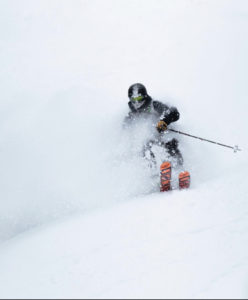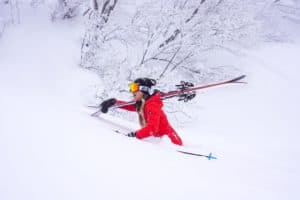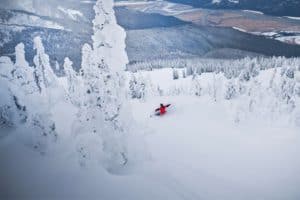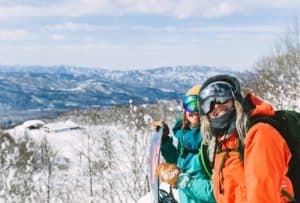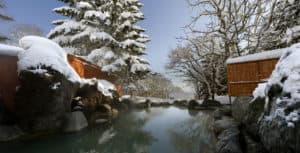
Mountainwatch | Nadine Robb
The Tohoku region is home to the snowiest city in the world, making it a perfect holiday destination for those looking for a truly immersive winter experience. With heavy and persistent snowfall shaping the communities and cultures of Tohoku, the experience you’ll encounter is one of authenticity, adventure and snow. Lots of snow.
As a die-hard, lifelong skier my mind admittedly wanders to the ski potential of the region – which is vast – but on this occasion I sense something more deeply rooted than the comparatively recent ski tourism upon which most international winter destinations have been built. Through the centuries, the humans of Tohoku have not just thrived through the extremes of winter, but welcomed, embraced and celebrated the seasons – creating a snow culture that won’t be found anywhere else on the planet.

Made up of several different prefectures, Tohoku spans the northern portion of Japan’s largest island, Honshu. Home to the world’s snowiest city of the same name, the prefecture of Aomori is blessed with both sprawling volcanoes and expansive coastline, as well as Honshu`s largest caldera lake – Towada. It’s exceptionally blue colouring is partially credited with its dizzying depth of 327 metres, and where many western lake communities may close up the boat houses over winterwhilst the canoes and the summer sun hibernates, those at Towadako Guidehouse do the opposite. After all, what better way to embrace winter than to canoe through the glassy waters of a snow edged caldera lake? The depth at the centre of the lake prevents it from freezing entirely, but the ice claims what it can of the shallows. Gliding along the ice rimmed perimeter, tree branches and vegetation are clad in thick, clear ice, accessorised with dangling icicles that chink and clink as you pass them by.
A cup of something warm mid-tour keeps the cold at bay, whilst also providing a surreal submersion into the depths of winter in the area. Gently bobbing in the canoe as you sip, mountains surround the crater lake in a way that is reminiscent of an amphitheatre – this is a setting that is sure to beat that of any coffee shop.

Contrasting the natural, raw experience of Lake Towada is the vibrant, historic city of Hirosaki. Located in the north of Aomori Prefecture, the white walled Hirosaki Castle and its colour splashed grounds are sure to steal the foreground of any Instagram worthy posts, while Fuji-like Mt Iwaki stands sentinel in the background. Though a visual, cultural and culinary treat throughout the year, the annual Yuki-Doro Festival (snow lantern festival) that takes place within the 400-year-old castle grounds is nothing short of other worldly. Handfuls of Hirosaki residents together with those from the surrounding region come to the castle for five days in February, during which they transform the grounds with their snowy creations. Towering lanterns, replicas of historically significant structures and mini kamakura – (igloos) – ensure that magic flows, while a huge snow slide is an automatic win for the kids (and maybe some adults too!).

All through the winter months the castle grounds are tastefully illuminated, while the thousands of sleeping sakura (cherry blossom trees) often have a thick blanket of velvety snow draped over their limbs, as soft, pink, ethereal lighting watches over them. The illusion of the snow sakura is powerful, and coincidentally, can shape the inner landscape of those watching closely enough.

As a region so rich in so many things, food is high up on the list. For Aomori, the most celebrated dishes are sourced from the ocean, which is unsurprising with so much coastline and the Tsugaru Strait off its shores. As the current in the Tsugaru Strait speeds up during the winter months, the Bluefin Tuna migrate from the Sea of Japan into the strait. At this time of year, the Bluefin Tuna caught in the Tsugaru Strait – known as Oma Tuna – are often much larger than those caught elsewhere, with a favourable fat content and sweet/savoury balance in the flavour profile. It is these Oma Tuna that have set world records and headlines for fetching astronomical prices at auctions – specifically at the Toyosu Fish Market’s first auction of the year.

An economical and fun way to sample some of Aomori’s best seafood is to visit the Furukawa Fish Market in Aomori City. A far cry from a sparkly city sushi restaurant, the Furukawa Fish Market is exactly what it says it is, with a handful of well used tables pushed against the wall so that you can sit down and sample the wares. Being steps from the ocean, everything is as fresh as it can be (and still alive in many cases), and handfuls of stalls line each ‘aisle’, offering an enormous array of marine cuisine. The best way to enjoy the widest selection whilst enjoying a completely original lunch experience is to order Nokke-Don. Essentially a bowl of rice and a handful of tickets, you can exchange these for different dishes from different stalls, thus creating your own lunch comprised of your favourite selections or the new ones that you’d like to try.

For the more adventurous eaters, a trip to Tohoku’s Fukushima Prefecture is in order to sample the regional speciality of Ankou Nabe. With deep roots in a history that spans centuries, this winter staple has well stood the test of time. Nabe, meaning hot pot and Ankou, meaning anglerfish, this hearty dish is made from the springy meat of the anglerfish and flavoured with miso. The liver of the anglerfish – known as ankimo – is also used to enhance the flavour and improve the texture. Popular among women for its high collagen content, its natural season is from December to February, lending itself to be the winter delicacy that it is today. If seafood is not to your taste, then the Tohoku region still has you covered. Dishes such as Hinai Jidori Oyako-don (eggs and chicken over rice) from Akita Prefecture are extremely popular with both locals and tourists.
Aside from its culinary offerings, Fukushima – like the rest of Tohoku – is not lacking in snow, adventure and unique winter experiences. As an iconic active volcano, Mt Bandai stands at 1819 metres tall and is flanked by volcanic lakes on most sides. While some of the lakes freeze during the winter, a curious cluster of vividly coloured ponds – collectively known as Goshikinuma (lit. five-coloured ponds, but the five refers to the colours, not the number of ponds, of which there are more) — is located on the northern side of the mountain, in the Urabandai region. While photos of the ponds could well call into question the use of Photoshop, they are in reality as they appear on screen. The depth and intensity of the colours seen between the ponds is a result of trapped volcanic material and minerals in the water. As they do not freeze during the winter months, they strike a stark contrast with the white snow that blankets the surroundings.

Given the amount of snow during the winter months, the best way to access Goshikinuma and other trails in the Mt Bandai vicinity is by snowshoe. By distributing your weight over a larger surface area, snowshoes provide an efficient and peaceful way to travel through remote winter-scapes. Some people snowshoe in order to reconnect with their surroundings (and possibly with themselves), while others may use it as a way to meet their daily cardio quota. And for some, it is both. Whatever the motivation, there is no question as to the health and wellness benefits that snowshoeing brings, and in this case, enabling access to some dramatically spectacular scenery.
A guided tour is the best way to make sure that no safety considerations are overlooked and will also maximise time by not having to navigate yourself in an effort to find the spots that you’d most like to visit. While Goshikinuma is special in its own way, gaining elevation on Bandai itself offers impressive views over Fukushima Prefecture. One of the best things about snowshoeing is that it is easy to get into for most people – children included – and requires minimal specialist equipment or skill.
And of course, no winter visit to Tohoku would be complete without floating down the Satetsu River as it snakes its way through a 2km stretch of the Geibikei Gorge. Essentially a glasshouse on a river boat so that no views are missed, the boatman navigates with a bamboo pole whilst singing traditional songs from the region. Freezing history in time, you can soak in the classically Japanese winter scenes as you drift past them from the warmth and cosiness of your Kotatsu (a low heated table with a blanket to put your legs under), as you indulge in your nabe. Or, you can opt for a more elevated experience with an on-board tea ceremony.
There is no shortage of memorable winter experiences in the Tohoku region, and not just those that you’ll find in any ski resort, but most of which you will not find anywhere else. In a time when so many paths are so well-trodden, a winter visit to Tohoku is one way to pioneer your own tracks in the land of the rising snow.
Find out more at about Tohoku’s winter experiences here.


